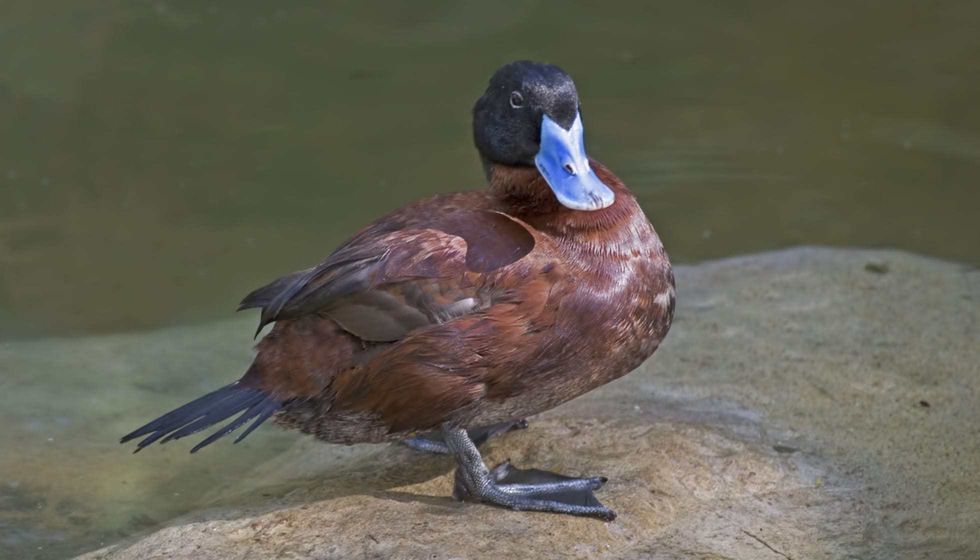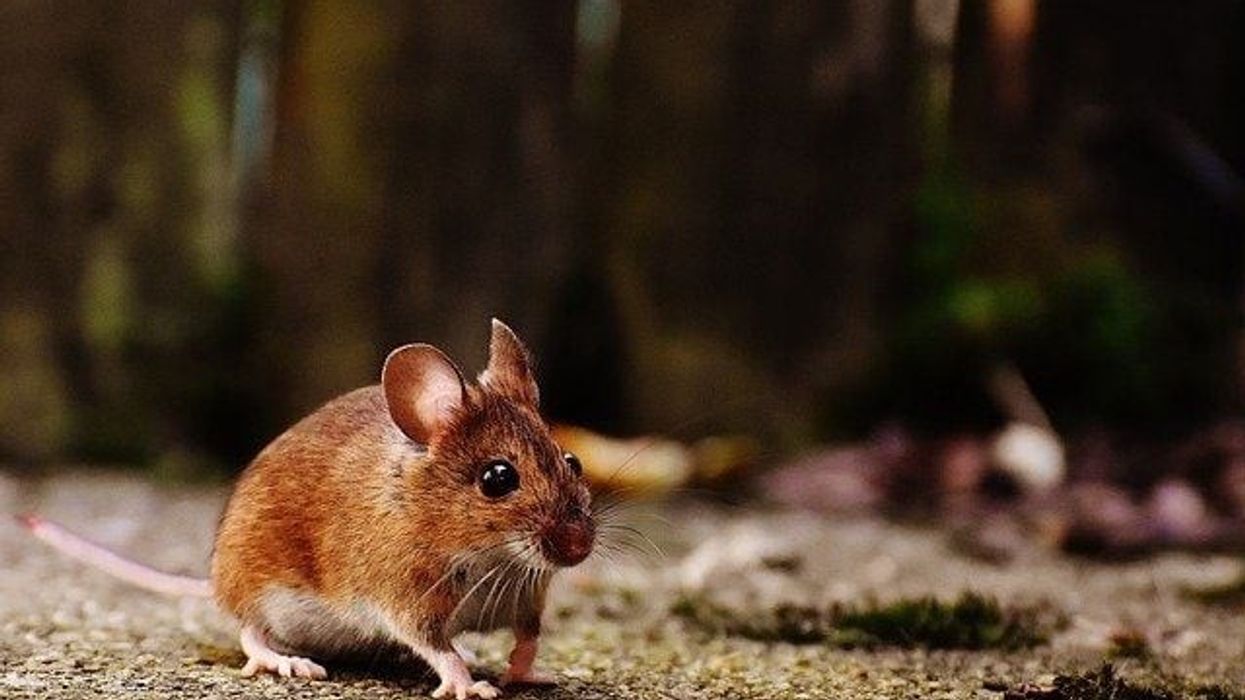Are you a bird lover and fascinated by ducks like the harlequin duck? Then you are in for a treat as we present to you one of the most exciting birds of the world, a species of stiff-tailed ducks, the Maccoa duck.
These are diver ducks, and their stiff tail brings out a majestic look when they are at rest.
The females and the non-breeding males differ in looks when compared to the breeding males. They are dark brown in color and have a cheek stripe.
The males in breeding plumage have a blue bill and a slender black head. The dark brown coloration of the entire body makes it easy to identify the two different sexes.
While the female has a dark brown plumage on their body, the breeding males have much brighter chestnut-colored plumage on their bodies. The bill of the females of these stiff-tailed ducks is brown in color.
These birds are known to build their nests in lakes where there is plenty of vegetation, thereby ensuring enough food supply. These are omnivorous birds and effectively feed on plants and small animals, which they can easily derive and forage from the vegetation located nearby.
If you find our animal facts content interesting, then do check out crested duck facts and Bombay duck facts!
Maccoa Duck Interesting Facts
What type of animal is a Maccoa duck?
The Maccoa duck (Oxyura maccoa) is a type of stiff-tailed duck that belongs to the Anatidae family.
What class of animal does a Maccoa duck belong to?
Just like all other ducks that are present on the globe, the Maccoa duck too belongs to the class of Aves of the Animalia kingdom.
How many Maccoa ducks are there in the world?
The International Union for Conservation of Nature or the IUCN Red List estimates that there are around 14350-16000 individuals that are currently present on the Earth today.
These birds have been listed as Vulnerable species, with their population steadily on the decline over the years owing to numerous human activities. Habitat loss, climate change, pollution, and hunting, and poaching have become some of the key factors that have led to the decline in the population of this species.
Proper conservation steps should be enforced else these wonderful birds will become extinct in no time.
Where does a Maccoa duck live?
The Maccoa duck (Oxyura maccoa) is predominantly found on the continent of Africa. These birds are spread widely in East African countries along with other countries from Southern Africa. In East Africa, the countries which are home to these birds are Tanzania and Eritrea, while in Southern Africa, these birds can be seen in Namibia and Zimbabwe.
What is a Maccoa duck's habitat?
The Maccoa duck's habitat involves places like shallow salt and fresh water bodies. These birds can also be found in the open waters as well as in reedbeds which are at a significant height from sea level. During the breeding season, these ducks are found in brackish lagoons and large lakes.
Who do Maccoa ducks live with?
These ducks are extremely social animals, and they live with one another in huge numbers. Flocks containing around 1000 individuals have been observed in many places.
How long does a Maccoa duck live?
Owing to very limited information, not much is known about the lifespan of the Maccoa duck (Oxyura maccoa). However, we can make a guess based on their genus, Oxyura, in which ducks live for around three to five years.
How do they reproduce?
The breeding season of these ducks has been observed throughout the year, where the peak months differ in both Eastern Africa and Southern Africa. These birds are polygynous in nature, the male bird has several mating partners and thus effectively doesn't form a pair bond with any partner.
The males are territorial in nature and can have almost eight different partners for mating. The nest is built by the female, usually over water and preferably where there is an abundance of vegetation.
Around 4-12 eggs are laid, which are then incubated by the female for around 25-27 days. The newly hatched chicks are known to stay with their mother for around eight weeks.
What is their conservation status?
The International Union for Conservation of Nature or the IUCN Red List has listed the Maccoa duck (Oxyura maccoa) as a Vulnerable species. The population trend shows that there has been a subsequent decrease in the number of individuals in recent years as well.
A wide number of factors are responsible for the decline of this species.
Human activities like the destruction of habitat, climate change, along with illegal hunting and poaching, have severely depleted the population of this duck species. Proper conservation steps should be implemented to preserve and protect these magnificent ducks.
Maccoa Duck Fun Facts
What do Maccoa ducks look like?

The breeding males are majestic looking and have a distinctive blue bill, a rufous body, and a black head. These birds also have a wonderful stiff tail, thereby giving them this wonderful name. The tail feathers are dark brown or black in color.
The females are not as colorful as the breeding males, and they, along with the non-breeding males, bear a dark brown cape with stripes of white on their heads and a cheek stripe. For the young ones or juveniles, the tail feathers are not as bright as in the case of the males.
The bill of the female is dark brown.
How cute are they?
Ducks are extremely cute animals, and thus the Maccoa duck (Oxyura maccoa) is no exception. These magnificent ducks are loved and adored by all ornithologists and animal lovers.
How do they communicate?
These ducks are silent in nature and are known to hardly make any loud noises or calls. The males are known to give up small whistles as well as 'prrrr' like vibrating sounds. In anticipation of any danger, both males and females are known to produce grunting sounds to warn and alert others of the imminent danger.
How big is a Maccoa duck?
Maccoa ducks have a length of roughly 18-20 in (45.7-50.8 cm). In comparison with the fulvous whistling-duck 16.5-19.3 in (42-49 cm), we can say both these species are similar in length.
How fast can a Maccoa duck fly?
Owing to very limited data and research, the exact speed at which these stiff tail ducks fly is currently unknown. However, we can make an assumption based on the flying speed of normal ducks. Ducks are usually fast fliers, and they normally attain high speeds of 40-60 mph (64.3-96.5 kph).
How much does a Maccoa duck weigh?
These birds weigh 1.1-1.8 lb (0.49-0.81 kg). In comparison with the Muscovy duck, at 6.6-15 lb (2.9-6.8 kg), we can say that the latter is more than six times heavier.
What are the male and female names of the species?
A male duck is referred to as a drake while a female is known as a hen.
What would you call a baby Maccoa duck?
Baby ducks are known as ducklings, and thus in the case of a baby Maccoa duck, it would be known as a Maccoa duckling.
What do they eat?
These birds are omnivorous in nature, they feed on both plants and animal matter. Predominantly these ducks feed on aquatic plants, seeds as well as small aquatic animals like crustaceans and worms. These birds of Southern Africa can also be found foraging on cattle waste.
Are they dangerous?
There is no evidence that suggests that these birds are dangerous to humans or fellow animals that share the same vegetation and habitat. Thus we can conclude that these birds are not dangerous at all.
Would they make a good pet?
No, it would be a bad idea to keep these birds as pets. First of all, these are wild birds that live in large flocks of their own.
Secondly, these ducks are categorized as Vulnerable species with their population on the decline, so they should be left out alone in the open. Lastly, in almost all places in the world, keeping a Vulnerable species is illegal, so it would be unwise to keep these birds as pets in your home.
Did you know...
Oxyura, the genus of these ducks, is further divided into two groups. Those are Old World ducks and New World ducks.
How many types of ducks are there?
There are 12 different types of ducks that are found on our planet. These 12 types of ducks are dabbling ducks, diving ducks, eider, goldeneye, merganser, perching ducks, scoter, sea-ducks, stifftail, teal, whistling ducks, and domestic ducks.
Do Maccoa ducks dive?
Yes, Maccoa ducks are a species of stiff-tailed diving ducks, which effectively means that these birds are expert divers.
Here at Kidadl, we have carefully created lots of interesting family-friendly animal facts for everyone to discover! For more relatable content, check out these red-headed woodpecker facts and bearded vulture facts for kids.
You can even occupy yourself at home by coloring in one of our free printable duck crossing road sign coloring pages.
Second image by Nasser Halaweh.










